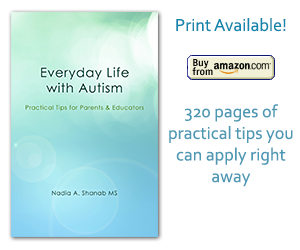Back–to-School! Is Your Child with ASD (Autism Spectrum Disorders) Ready?
Nadia Shanab | autism, general advice, parenting5 Aug 2012
Soon classrooms will open their doors to welcome their new and returning students.
One of the most common traits of autism is the love for sameness and rigidity. Individuals with autism fear changing their routine and experiencing new situations. The outcome of a new experience is unpredictable. Routine activities, on the other hand is guaranteed to always give the same result. An unpredictable situation requires extra mental processing of information, and more time to adapt to, and accommodate a new context. It is an emotionally exhausting process.
How can you prepare your autistic child to start a new school year – and all of the challenges that it encompasses – in a smooth and peaceful way?
1- Take a trip to the school site to familiarize your child with the campus and playground. Have her/him spend some time playing and having a good time there. Explain to her/him that this is the new school she/he’ll be joining soon. You may even encourage her to go by bike or scooter (if close enough) to associate some fun to the concept of going to school. It is also a great opportunity to familiarize her/him with the playground rules.
2- It would be ideal if you could find out a bit about your child’s future classmates. That will allow you to arrange play dates to introduce her/him to her/his new friends. It is also a great opportunity for you as a parent to connect with other parents. Both of you need each other’s support. Community support groups have an amazingly relieving effect on parents. Solidarity will help you be a stronger, and more informed and effective parent. You are not alone!
3- If your child is going to ride the school bus, find songs, stories and books about the school bus, and tell her that being on the bus will require that she pays attention to the bus driver’s instructions, and behaves respectfully toward the other kids on the bus. For example, if there is an assigned seat for her/him, she/he should comply with the authorities. There is usually a good reason behind the bus seating. Everybody’s safety is a primary concern.
4- Make one change at a time. If your child needs new eyeglasses, orthodontic braces, a hearing aid, or any other addition that requires adaptation and adjustment, do it ahead of time before school starts; even a simple hair cut. Similarly, if your child will have a new babysitter or caregiver, it is preferable that you introduce them to each other promptly. Have them spend some time together in your presence.
5- Prepare a list of your child’s likes and dislikes to share with the staff. Give them enough information that would help them engage with her/him based on her/his special needs. Give them the cues that would help them interact and communicate with her/him in a pleasant, non-confrontational manner. For instance, give a list of her/his favorite colors, books, toys, games, subjects, rewards, and incentives. You may also want to explain some special behaviors to avoid any misunderstandings.
6- If the child is non-verbal, provide the staff with the strategies you use at home that work best for her/him. Visuals are always great (signs, symbols, pictures, objects…).
7- Consistency plays a crucial role in disciplining your child and helps in avoiding them getting into trouble or throwing a needless temper tantrum. School should be a continuation of home, and vice versa. Whatever rule is applied at home should also be applied at school. In order for this to happen, you need to be a good communicator. Talk to the teacher and learn about the rules at school and let her/him know what rules and strategies you apply at home. Together, agree on a protocol to provide your child with the most appropriate and effective educational plan.
8- If your child is going to school for the first time, she/he might suffer from separation anxiety. Ask the teacher if you could stay in the classroom and then do a gradual withdrawal, until your child gets used to the new environment. This is most helpful for the staff and the child.
9- If your child has a comfort object (cushion, spinner, hand massager…) to reduce her/his sensory problems, it might be a good idea to keep another one at school.
10- Help your child get used to the new schedule by setting a time to waking up and going to bed. By the time school starts the routine would already be effective.
11- Buy all the necessary stationaries, lunchbox, shoes, clothes, sports gear, etc. Make sure to buy practical shoes and clothes for school to allow the staff easier and faster handling. Velcro type shoes are easier than the shoelaces ones. Elasticized pants’ waist is easier then regular ones. Remember that getting used to use all the new stuff will take your child some time.
12- Prepare a preliminary schedule and display it on the fridge, your child’s bedroom,…Make it colorful and use pictures and signs to make it easy to understand. Get your child in the habit of checking her/his schedule frequently. She/he will be doing the same at school.
Those were a few tips that will hopefully allow your child to have a smoother transition to enjoy a productive and successful school year. Cheers!
HAPPY SCHOOL YEAR 2012-2013!
nadia
Tags: autism, books, communication, consistency, discipline, flexibility, parenting, rules, schedule, sensory, visual aids
